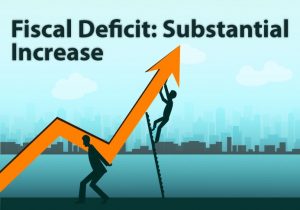Increased Fiscal Deficit:

The government’s fiscal deficit has increased to Rs. 11.58 lakh crore or 145.5% of the Budget Estimate (BE) at the end of December 2020 (accounting for the first nine months of the year 2020-21) mainly on account of lower revenue realisation.
Key Points:
- Fiscal Deficit Target Fixed for 2020-21: The Centre had pegged the fiscal deficit at Rs. 7.96 lakh crore or 3.5% of the Gross Domestic Product (GDP).
- Fiscal Deficit in 2019-2020: According to the data released by the Controller General of Accounts (CGA), the fiscal deficit at the end of December in the previous fiscal year was 132.4% of the BE of 2019-20.
Reasons for High Fiscal Deficit:
Lower Revenue Realisation:
- Because of disruptions in normal business activity following the coronavirus pandemic and lockdowns.
Higher Expenditure:
- There has been a notable increase in revenue expenditure in food and public distribution and rural development which could be attributed to the government’s pandemic relief programs.
Fiscal Deficit
- The government describes fiscal deficit of India as “the excess of total disbursements from the Consolidated Fund of India, excluding repayment of the debt, over total receipts into the Fund (excluding the debt receipts) during a financial year”.
- In simple words, it is a shortfall in a government’s income compared with its spending.
- The government that has a fiscal deficit is spending beyond its means.
- It is calculated as a percentage of Gross Domestic Product (GDP), or simply as total money spent in excess of income.
- In either case, the income figure includes only taxes and other revenues and excludes money borrowed to make up the shortfall.




